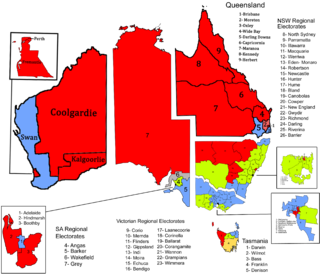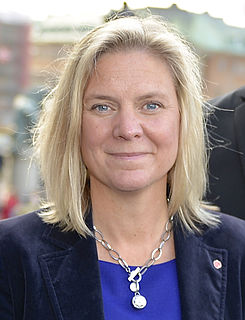
The period following the accession of Oscar II to the throne of Sweden in 1872 was marked by political conflict. The Lantmanna Party, representing peasant proprietors, dominated the Lower House of parliament, and demanded tax reductions and reforms of the system of military service. The Upper House opposed these positions. A compromise was reached in 1884 with reduction in land taxes and increased periods of military service, processes that continued in later years.
The Free Trade Party which was officially known as the Australian Free Trade and Liberal Association, also referred to as the Revenue Tariff Party in some states, was an Australian political party, formally organised in 1887 in New South Wales, in time for the 1887 colony election, which the party won. It advocated the abolition of protectionism, especially protective tariffs and other restrictions on trade, arguing that this would create greater prosperity for all. However, many members also advocated use of minimal tariffs for government revenue purposes only. Its most prominent leader was George Reid, who led the Reid Government as the fourth Prime Minister of Australia (1904-5). In New South Wales it was succeeded by the Liberal and Reform Association in 1902, and federally by the Anti-Socialist Party in 1906. In 1909, the Anti-Socialist Party merged with the Protectionist Party to form the Commonwealth Liberal Party.
The Commonwealth Liberal Party was a political movement active in Australia from 1909 to 1917, shortly after Federation. The CLP came about as a result of a merger between the two non-Labor parties, the Protectionist Party and the Anti-Socialist Party which most of their MPs accepted. The CLP is the earliest direct ancestor of the current Liberal Party of Australia.
Liberalism in Australia dates back to the earliest pioneers of the area, and has maintained a strong foothold to this day. Liberalism in the country is primarily represented by the centre-right Liberal Party. The Liberal Party is a fusion of liberal and conservative forces and are affiliated with the conservative centre-right International Democrat Union. The term "little-l liberal" is often used to distinguish philosophical liberals from members of the Liberal Party.
This is a list of the members of the Australian House of Representatives in the First Australian Parliament, which was elected on 29 and 30 March 1901. There were 75 members, as required by the Constitution, as near as possible to twice the number of Senators which was then 36. South Australia and Tasmania had not been divided into electoral divisions in 1901 which resulted in the particular state voting as a single electorate, with each elector casting seven votes. The seven candidates with the highest votes
were elected.

Baron Didrik Anders Gillis Bildt was a Swedish parliamentarian, military officer, baron and prime minister 1888–1889.

Federal elections for the inaugural Parliament of Australia were held in Australia on Friday 29 March and Saturday 30 March 1901. The elections followed Federation and the establishment of the Commonwealth of Australia on 1 January 1901. All 75 seats in the Australian House of Representatives, six of which were uncontested, as well as all 36 seats in the Australian Senate, were up for election.
The Liberal Reform Party was an Australian political party, active in New South Wales state politics between 1901 and 1916. It drew much of its support from Protestant and Temperance groups.
The Progressive Party was an Australian political party, active in New South Wales state politics. The question of tariff policy which, had created and divided the Free Trade Party and Protectionist Party in New South Wales in the 1890s, became a federal issue at the time of federation. Deprived of their main ideological difference, the two parties were recreated as the Liberal Reform Party aligned with the federal Free Trade Party and the Progressive Party aligned with the federal Protectionist Party. The Progressive Party collapsed in 1907, leaving the Liberal Reform Party as the main anti-Labor Party.
In 1919, the Farmers' and Settlers' Association and the Graziers' Association founded a new Progressive Party, which won metropolitan and rural seats in the 1920 election.
This is a list of the members of the Australian Senate in the First Australian Parliament, which was elected on 29 March 1901. There were 36 senators in this initial parliament. Terms were deemed to start on 1 January 1901. In accordance with section 13 of the Constitution, the Senate resolved that in each State the three senators who received the most votes would sit for a six-year term, finishing on 31 December 1906 while the other half would sit for a three-year term, finishing on 31 December 1903. The process for filing of casual vacancies was complex, with an initial appointment followed by an election. The status of political parties varied, being national, State based, and informal.

Federal elections were held in Australia on 16 December 1903. All 75 seats in the House of Representatives, and 19 of the 36 seats in the Senate were up for election. The incumbent Protectionist Party minority government led by Prime Minister Alfred Deakin retained the most House of Representatives seats of the three parties and retained government with the parliamentary support of the Labour Party led by Chris Watson. The Free Trade Party led by George Reid remained in opposition.
Federal elections were held in Australia on 12 December 1906. All 75 seats in the House of Representatives, and 18 of the 36 seats in the Senate were up for election. The incumbent Protectionist Party minority government led by Prime Minister Alfred Deakin retained government, despite winning the fewest House of Representatives votes and seats of the three parties. Parliamentary support was provided by the Labour Party led by Chris Watson, while the Anti-Socialist Party, led by George Reid, remained in opposition.

The Minister for Finance of Sweden, officially Cabinet Minister and Head of the Ministry of Finance, is a member of the Government of Sweden and is the head of the Ministry of Finance.
The Protectionist Majority Party of the Upper House was a political party in Sweden, founded in 1888. It was a conservative and protectionist party. Two politicians from this party, Gustaf Åkerhielm and Christian Lundeberg, served as Prime Minister of Sweden. In 1912 the Protectionist Party became part of the National Party.

John Moore Chanter was an Australian politician, farmer and commission agent. He was a member of the Protectionist Party, as well as the Australian Labor Party and the Nationalist Party of Australia.

Thomas Macdonald-Paterson was an Australian politician, a member of the Parliament of Queensland, and later, the Parliament of Australia.
The Western Australian Party (WAP) was a short-lived Australian political party that operated in 1906. It was intended as a liberal party to protect the rights of Western Australians and to oppose the increasingly successful Labour Party, and drew its supporters from the Protectionist Party and the Anti-Socialist Party. John Forrest, a minister in Alfred Deakin's government, accepted the leadership of the party. Candidates were endorsed for all electorates in the 1906 federal election, including Forrest, but by the time of the election enthusiasm for the venture had diffused. The party elected Forrest in Swan and William Hedges in Fremantle. In practice they sat as independents and joined the Commonwealth Liberal Party when it formed.
General elections were held in Sweden in September 1893. Protectionist candidates received a plurality of the vote. Erik Gustaf Boström remained Prime Minister.






